Post by Heraldic collection conservator Louise O’Connor
All organic materials degrade. Historic manuscripts are handmade, unique artefacts combining parchment, paper, animal glues, pigments, inks, threads and leather. Unless left untouched in an oxygen free environment, these components may lose strength, discolour and can fall apart!
Treating unique and degraded manuscripts can be a key part of a digitisation project. Over the last 4 years, in a project supported by the Department of Culture, Heritage and the Gaeltacht, the NLI team has been working to make 17th century heraldic manuscripts available for free online. These manuscripts come from the collection of the Office of the Chief Herald. They are part of a tradition of heraldry that originated in the medieval period, to regulate armorial bearings, or “coats of arms”, originally used to identify people on the battlefield and later to attest documents and indicate ownership. For a system of identification to be effective, it requires regulation - the use of the same arms by more than one person would result in confusion. Specialists, known as heralds, were needed to keep the necessary records and advise on all related matters, and this tradition continues at the National Library of Ireland to this day.
As part of this project, conservation treatment of damaged and delicate manuscripts was required to facilitate digital photography. Scientific visual investigation is key to understanding the physical chemical and biological ageing of materials. Let’s take a closer look at manuscripts through the eyes of a conservator:

Heraldic manuscripts with drawing of pink dragons; the binding is tight and hides the drawing (GO MS 31)
A binding is a mechanical object; it should open and close and is the sum of its parts. The heraldic manuscripts were poorly bound or restored (‘rebacked’) with too much protein based adhesives on the spine from the 19th century. Hot animal glue was used for centuries by bookbinders. It has strong adhesive properties, but will quickly degrade; shrinking and crosslinking. This prevents the binding from opening and means that readers can no longer see drawings and script along the inner edge.
Paper is an organic cellulose material. The paper in the heraldic manuscripts dating from the 16th and 17th centuries was hand-made using linen and cotton rags, from items such as old ship sails and old underwear. In fact, wonderful papermakers’ marks, known as watermarks, can be seen in the sheets with transmitted light (images recorded on ‘Watermarks Irish Documents project '.
Cellulose is a linear polymer. Acid catalysed hydrolysis of the cellulose polymer causes the polymer chains to break resulting in weak or brittle paper). It also degrades by oxidation, especially if exposed to light or excessive airflow. Oxidation forms carbonyl groups called chromophores which give degraded paper a distinctive yellow colour. Old manuscripts even have a distinctive smell.
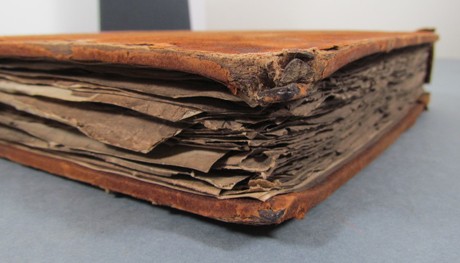
Paper is organic and degrades by oxidation and hydrolysis. Dirt particles stick to the paper fibres with weak chemical bonds. (GO MS 19 - before treatment)
The heraldic manuscripts were covered in layers of surface dirt as a result of poor storage in the past. Small dirt particles are held to the uneven surface of paper by weak forces, called Van der Waals forces. Dirt particles can transfer from hands during reading, and airborne particles (i.e. dust) will slowly settle on paper over time. Surface dirt particles are disfiguring and abrasive, and will reduce the pH of the paper and catalyse further chemical degradation.
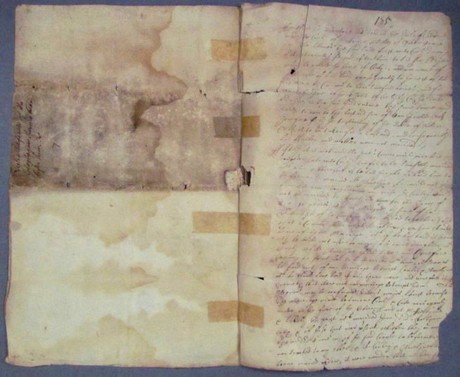
Purple blotches and brown lines are evidence of mould and water damage on historic paper. (GO MS 85 - before treatment)
Water can damage paper and it is something to which paper conservators working in rainy Ireland are accustomed! As cellulose molecules have many hydroxyl groups, paper has a high affinity for water. This is why water is used in papermaking and paper conservation (more on that later). Yet, it can take paper a long time to dry out and in this lag time (min 48 hours) mould can grow. Mould eats paper, making it fragile (think damp toilet paper) and very difficult to handle. Historic repairs added the some folios in the heraldic manuscripts, though well intentioned, only compound the difficulty in handling.
Iron gall ink can ‘rust’ paper as it degrades. This is a huge problem, as up until the 19th century, ink made from oak galls was very common in Europe. Homemade recipes combined tannins (from crushed galls), iron sulphate (an ancient material known as copperas or green vitriol) and water to varying amounts. However, the ink corrodes with too much sulphuric acid and free iron (II) ions, in high relative humidity (it averages 70-85% in Ireland).
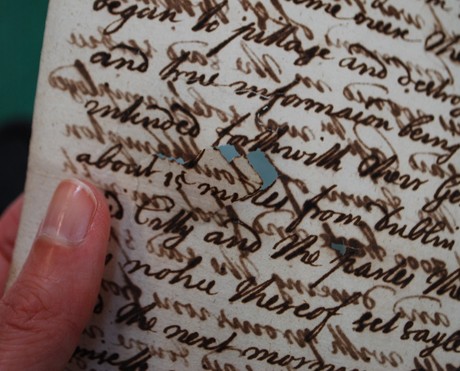
Ink containing iron can be chemically unstable and damage the paper. (GO MS 85)
Iron gall ink corrosion degrades cellulose in stages. Fuzzy ink lines are first noticeable as the iron ions move into the paper. Next the script becomes visible from the back as the iron ions move through the paper. Finally, the ink lines will crack or simple fall out of the paper leaving a lace-like pattern. This leads to loss of valuable text due to significant destruction of the paper along the ink lines.
Colour is an essential element of heraldic art; the use of each colour is symbolic. On manuscripts, ground pigment or dyes were mixed with a water-soluble binder, such as gum arabic and finely applied onto the surface of the paper or parchment. Unlike oil paintings, there is no varnish.
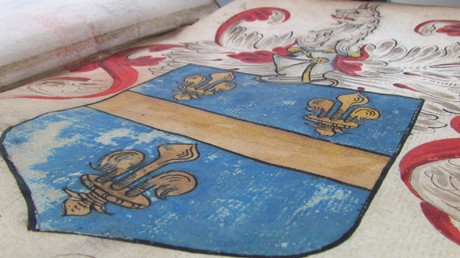
Blue pigment particle loosely held to the paper surface by weak chemical bonds and binder and are easily detached through handling. (GO MS 32)
Colour on paper is very fragile. The pigment particles are loosely held to the paper surface by weak chemicals bonds and a thin binder layer which forms a film. In the Heraldic manuscripts, the colours appear opaque and matt due to a low ratio of binder to pigment or high ‘pigment volume concentration’. Cleavage is the term used to describe the break between the paint layer and the paper substrate.
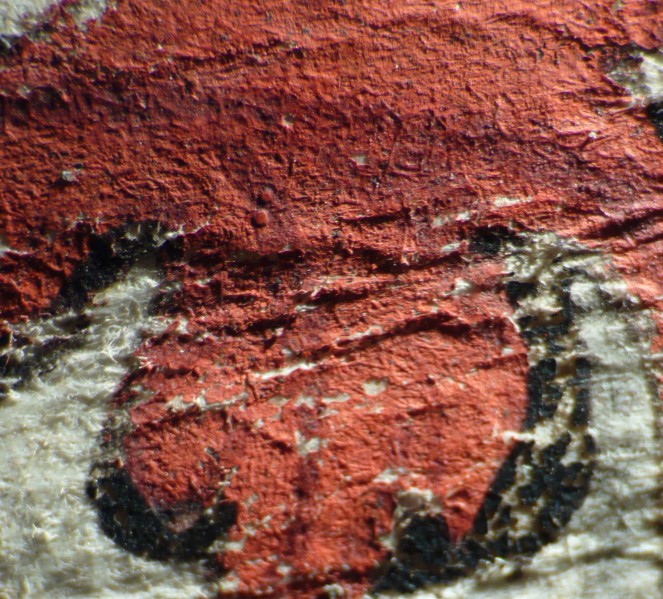
Repetitive use, like flexing the paper support, results in the loose pigment particles flaking off. Pigment layers can also turn into powder. This can happen from abrasion.By looking at the pigment layers with magnification, conservators can assess the extent of damage.
Pigments can also dramatically change colour due to chemical changes in their structure. White lead is a pigment made from basic lead carbonate, 2PbCO3·Pb(OH)2. It was used for centuries by artists but was so toxic it was eventually banned. White lead was often used to highlight the flesh tones of figures in manuscript illuminations. It reacts with trace amounts of hydrogen sulphide in the air to produce black lead sulphide. This can impact how researchers read these images today.

Blackening of white pigment, possibly lead white, is visible on the face and arm of the woman in this image. (GO MS 31)
Science plays a central role in modern conservation of cultural heritage. By understanding the chemical structure of materials, a conservator can document the condition and potential degradation of historic objects. Have you enjoyed taking a closer look at the heraldic manuscripts through the eyes of a conservator? Find out more on how science helps the treatment of delicate and damaged manuscripts in our next blog post.
